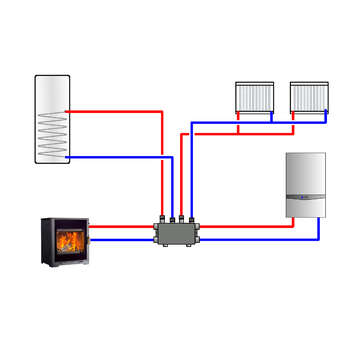Linking a woodburning boiler stove in with your central heating system
Many people are looking to reduce their gas and oil bills by installing a boiler stove. Rather than being totally reliant on the stove, the simplest is to link a woodburning boiler stove in with your existing boiler. This will mean that every time the the stove is lit the conventional boiler will shut off and the stove will take over the house heating and domestic hot water. When the stove isn’t lit the existing boiler will carry on working as normal.
Usually the wood stove will be burnt in the evenings and at weekends which is when, with everyone home, the need for heating and hot water is at its highest. Using a wood boiler stove in this way quickly leads to a significant drop in gas, oil or electricity bills.
There are a couple of main ways to link a boiler stove into your existing heating system and they are using a SystemZone, or using a thermal store
Connecting a boiler stove to your heating system with a SystemZone

Linking a boiler stove into an existing system is straightforward and there are a lot of advantages to using a SystemZone. A SystemZone is essentially a metal box with quite a few pipe connections which gives you a central point to connect your existing boiler and the wood boiler to. The heat for your hot water cylinder and central heating are then taken from the SystemZone. It’s cleverer than just a metal box in that the hot and cool water aren’t just mixed together - they are routed to where they are needed. A SystemZone lets you easily run both boilers at once if it’s very cold, or just one at a time, and it makes adding in controls easier to do.

Pros:
- Gives good flexibility and control - you can have both boilers on at the same time, or just one at a time.
- It allows you to easily heat your hot water cylinder from the heat from the wood.
- Installed close to your existing boiler it allows you to use existing valves and controls that you have in place to decide whether to heat the hot water cylinder or radiators, or both.
- It’s conceptually easier for an installer (and you) to understand - meaning a simpler installation process and easier to understand and maintain at a later date.
Cons:
- No option to store up heat for later.
- No option to add in solar thermal or other sources of heat later.
Connecting a boiler stove to your heating system with a thermal store

A thermal store acts as a central point to connect all heat sources to (at bit like a very big SystemZone). As the name suggests a thermal store also stores up heat for when you need it. This is often ideal in combination with a boiler stove installation that is meant to heat your whole home because people tend to light them in the evening, so it can be ideal if there is stored heat available for a bit of heating in the morning too. A thermal store also gives you the ability to add in other heat sources like solar thermal, an electric immersion powered by excess solar PV and so on.
Pros:
- Allows you to store up heat for later. If you want to run your home entirely using a wood boiler then this is an important consideration for those times when you want a bit of heat but the stove is not lit.
- Lets you add in solar thermal or other sources of heat later.
- Can potentially replace your hot water cylinder possibly freeing up space in the house.
Cons:
- Thermal stores are big and need a fair bit of installation space.
- Thermal stores add to the cost - both in terms of how much they cost and the labour and parts.
- Whilst a thermal store isn’t super-technical (it’s basically just a big insulated water tank with a lot of pipe connection points), your installer does ideally needs to be familiar with some of the concepts involved - so that narrows down which installer you might be able to use.
Other things to consider when linking in a boiler stove
A boiler stove that is designed to go on a pressurised system, and incorporates an overheat safety valve, makes the installation even simpler. A non-pressurised stove will require heat exchangers in the system.
In a normal set up the woodburner will heat up the radiators, heat up the water in your hot water tank as well as giving warmth directly into the room where it is installed. Woodburning stoves are also good at spreading a background warmth around the house if the situation allows.

A boiler stove should always be installed with a load unit. This both protects the boiler in the stove from condensation and ensures that the stove always burns cleanly and efficiently.




